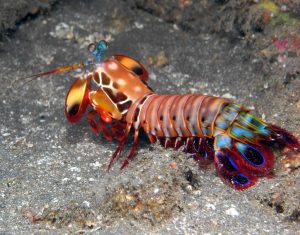
Mantis Shrimp
Mantis shrimp, also known as stomatopods, are fascinating marine crustaceans known for their vibrant colors, complex behavior, and powerful appendages. Here are some interesting facts about mantis shrimp:
Species Diversity: Mantis shrimp belong to the order Stomatopoda, which comprises over 450 known species. They are typically divided into two main groups: smashing mantis shrimp (smashers) and piercing mantis shrimp (spearers), based on their hunting techniques.
Colorful Appearance: Mantis shrimp exhibit a wide range of vivid colors, including shades of green, blue, red, and orange. Their striking hues are often a result of pigments in their exoskeleton, but some species can also display iridescence.
Powerful Strikes: Mantis shrimp are renowned for their incredible striking ability. Smashers have specialized appendages called “raptorial claws” that can strike with tremendous force, capable of shattering the shells of prey and even breaking aquarium glass. Some species can strike at speeds of up to 50 miles per hour (80 kilometers per hour).
Vision: Mantis shrimp have one of the most complex visual systems in the animal kingdom. They possess compound eyes with highly advanced color receptors, polarized light detection, and the ability to perceive ultraviolet light. Their eyes are on stalks that can move independently, providing a broad field of vision.
Hunting Techniques: The hunting strategies of mantis shrimp vary between species. Smashers use their powerful claws to deliver a swift, hammer-like strike, while spearers use their sharp, barb-tipped claws to impale prey. They feed on a variety of organisms, including crustaceans, mollusks, fish, and even other mantis shrimp.
Burrowing Behavior: Mantis shrimp are generally solitary and occupy burrows in the substrate, such as sand or coral rubble. They construct complex burrow systems, often with separate chambers for different activities like feeding, mating, and molting.
Communication and Courtship: Mantis shrimp use a combination of visual displays and chemical signals to communicate with each other. During courtship, they perform intricate displays, including vibrant color changes, rhythmic body movements, and antennal movements to attract potential mates.
Lifespan and Reproduction: The lifespan of mantis shrimp varies between species but generally ranges from 3 to 20 years. They exhibit a variety of reproductive strategies, including both sexual and asexual reproduction. Some species engage in elaborate courtship rituals, while others are known to reproduce through cloning or hermaphroditism.
Ecological Importance: Mantis shrimp play an important role in marine ecosystems as predators and scavengers. They help control populations of small organisms, and their burrowing activities can influence sediment mixing and nutrient cycling in coastal areas.
Conservation Status: While mantis shrimp populations are not extensively studied, some species face potential threats from habitat degradation, overfishing, and the destruction of coral reefs, which are vital to their survival. Further research is needed to better understand their ecological significance and conservation needs.